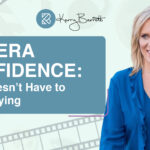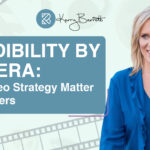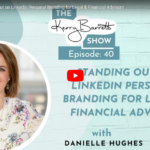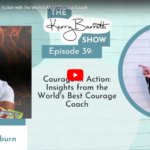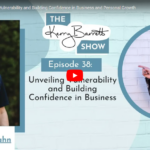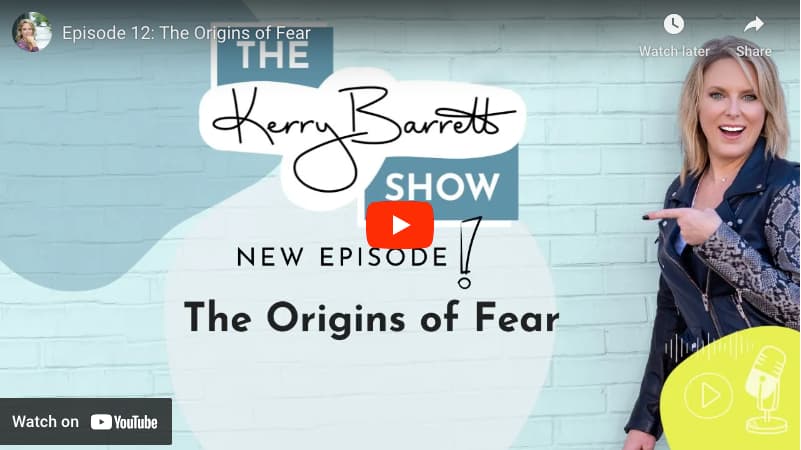
In this episode, we explore the origins of fear and how it manifests in various situations, including public speaking. We discuss the deep-rooted fear of being judged, rejected, and experiencing lowered status. We reference a study that revealed public speaking as the number one fear, even surpassing death. The episode concludes by assuring listeners that they are not alone in experiencing this fear and that it affects many individuals.
Transcript
Kerry Barrett 15:20:26
Welcome back, friends, thank you for listening. We have got a deep topic that we need to talk about today. And I promised you in the last episode, we are going to dive deeper into the origins of fear. But I want to preface all of this by saying, this can manifest in any number of ways for people who are, you know, have either spoken on a stage or spoken in front of a camera, have considered it, but they have opted not to because they’re so tired. This fear is applicable, no matter where you show up in front of an audience. So there’s a skit that Jerry Seinfeld did, let’s listen and show some of that right?
Kerry Barrett 15:21:09
I saw an actual study that said, speaking in front of a crowd is considered the number one fear of the average person, I found that amazing. Number two was death. Death is number two, because we’re used to the average person, if you have to be at a funeral, you would rather be in the casket than doing the eulogy.
Kerry Barrett 15:21:35
The fear of public speaking is very deep. And we may understand it as we don’t want everybody looking at us. And we’re afraid of being judged. And we have a fear of rejection or lowered status, if we make a big mistake and status sounds superficial. But if you keep diving into the why very often it ends up as I don’t want to experience lowered status by rejection, by judgment, by fear by making a mistake that will hurt me or hurt my family or affect people’s opinions of me. I’m going to dive into that in a second. But I want you to know that you’re not alone. And this fear pops up for so many people, there was a study done back in 19, the early 2000s, or late 90s, out of University of Southern California. And in this study, a psychiatrist took two groups of people to, you know, equal, for the most part in terms of attractiveness in terms of background in terms of abilities, in terms of intelligence, etc, and gave these two groups of 10. The exact same task, right, and it wasn’t a complicated task, it was just something they had to do together, like, put a puzzle together. And one group was left on their own to do it. And the other group was photographed and videoed during the course of that task that they were doing. And they found that as soon as the cameras were taking photos, and the video was rolling, the group universally, who was being videoed and photographed, felt their enjoyment of that task, and their self esteem, take a nosedive. And part of that is because listen, when we’re on camera, and we’re on video, there is no escaping from reality, it’s very clear, you know, if we’re self conscious about the weight that we’ve gained, or we have always not liked, you know, I don’t know, our nose, I hate my nose. That’s why it’s at the top of my mind, we become very aware of those things we get in our own head. And it destroys our ability to live in the moment and enjoy it right. Part of the talent of being able to speak on camera is to set all that stuff aside, you may feel it, you may still think it, I still hate my nose. And I sometimes hate the way my mouth moves when I talk. However, I’ve learned to compartmentalize it, so that it is out of my mind. And I’m not thinking about it when I am speaking on camera, or I am speaking on a stage like I can actually talk about it and it still doesn’t affect me. Once you begin to get in your head about those things, you have these sort of two divergent trains of thought. One is all the head trash, I hate my nose, oh my gosh, I gained 10 pounds, I’m not very good at this. And the other is what you’re supposed to be doing or saying. And unless you’re very skilled and very savvy, it’s very hard to bring those two trains of thought back together. Again, that is where the challenge lies. The practice comes in, not, you know, not carrying any longer about the 10 pounds or the size of your nose or whatever it is that bothers you, but being able to compartmentalize it and just sort of dissociate from it and continue on. And that’s what I had to learn pretty much when I was in the news, because I was doing it every day if I got in my head and I did plenty of times, especially when I first started. It was you know, it was a done game. And so when you take the fear of public speaking, and you talk about bringing that on to a camera out where you know, you are going to be judged by strangers at scale. And it’s going to live on the interwebs forever, and people can comment on, you know, the cheap seats about your nose or your weight, or whatever it is, along with whatever you’re saying. Those are like, two perfect storms combined into one mega storm. All right, so let’s talk about where the fear we understand, you know what this is? Why are we so scared of it, and it goes way, way back to our caveman brain, or our reptilian brain, as people call it sometimes as well. And the fear of being seen, the fear of being on camera, the fear of being watched, has many different terms, there’s a lot that’s less of phobia, and there’s a bunch of different ones. The one that I’m talking about specifically here is called sculpture phobia. And it is the fear of being seen and getting up in front of people. It’s an actual phobia part of the public speaking and speaking on camera, now that we understand the definition, and that it goes way back millennia, we begin to understand why we have such a problem overcoming it, but let me tell you how it started. millennia ago, when we were out of the cave, and you know, away from our caveman clan, we were at a great danger of being attacked, there was a saber toothed Tiger around every corner, there was a hungry crocodile in every watering hole, and there was a giant venomous snake under every rock and hanging from every tree. And so especially when we were alone, and we were up on the horizon hunting or gathering or whatever it was that we were doing, we were trying to be as small as possible, we wanted to be quiet, we didn’t want to make any sort of sudden or big movements. And we sort of salt and sculpt along, you know, the ground doing what we needed to do, especially when we were alone. And the reason for that is when you are by yourself, and you are on the horizon, and you are making, you know, loud noises and big movements, you draw the attention of every single predator around you, you make yourself vulnerable. Okay, so these pieces are hopefully beginning to come together for you. Now, additionally, if you were kind of near some of the members of your clan, right, they have the same fears that you do. And if you made these loud noises, and these big movements near the Klan, you also drew the predators attention to them. So not only were you likely to be eaten or seriously injured by a predator, you were also going to be rejected by your cave members’ lowered status, because you just put them in jeopardy as well. So they are rejecting you, they are kicking you out of the cave, because you can control yourself. And now it is a shore, likely painful death for you. And so all of those elements come together, rejection, lowered status, mistakes, death. And when you are up on a stage or you are in front of a lens, your caveman brain thinks about past experiences that you have had, where things maybe haven’t gone right and you’ve created a false belief and a story around it. And that amplifies those almost genetic fears that we have of being in front of a crowd, or being on the horizon and making loud noises and making big movements. you view the crowd as a predator, not consciously. But when that fear creeps up, that’s what your body is telling you. That crowd is hostile. And that crowd wants to attack you. And if you make a mistake, the people who you hope to support your family and your friends will reject you. And that’s where all of this begins to swirl and sort of make that perfect storm. Now the key, of course, is being able to, to understand the fear and then compartmentalize it so that you’re out of your own head and you’re putting the audience’s needs in front of your own fears, which is much easier said than done. Trust me, I know I have been there. And it is only through desensitization and practice and understanding the skills to deliver. So I know I’m doing a good job and my audience is hopefully compelled for the most part to listen to me, it is the combination of all of those things, the skill, the practice, the being able to compartmentalize, and then make that connection with the audience. Again, this applies whether you’re on a physical stage, or you are on a virtual stage, much like, if you’re watching or listening to this, I am on a virtual stage. And so one of the things that people try and do when they are practicing this on camera or on the stage is that they make a mistake. And then they stop, and they start all over again. And it’s because most of the time, you’re trying to get it perfect. That will never happen. Even the best operators on camera personalities, whatever, it doesn’t matter. They all make a mistake, president and a presidential address, a CEO making a statement to the press or to their team, that you on social media live or recorded, it will absolutely 100% never be perfect. And so if you’re not able to figure out how to navigate that mistake in real time, you are going to create a world of difficulty for you. When it comes to putting yourself on video for a few reasons. When you are able to navigate those mistakes in real time. You give yourself the ability to do live streams, live presentations, and so much more. Because you know, you can handle whatever comes your way, that part grows confidence and you begin to stop overthinking things. And then when you have that part down, it makes the creation of recorded video or audio like this so much easier as well. Because you’re not overthinking it, you’re not doing 85 takes in this case, I’m doing one. Now if you’re doing a social media post video post, maybe you’ll do two or three, but you’re not going to do 100. Or if you’re doing a video brand story for your website, you’re not going to need to do a bazillion because you’re seeing mistakes that other people don’t. But practicing through them gives you the muscle memory and the skills to navigate out of that mistake when it happens in real time. And it builds confidence so that your creation of recorded content is much quicker and much more efficient. That is what changed things for me. Back when I was a news anchor. It was when I had to navigate, I had built the skills and all that other good stuff. But I was still reliant on trying to be perfect when I had to let go of a script during breaking news and everything went to shit. And I managed to come through on the other side and dig my way out of whatever hole I had dug myself into or technology had dug the whole show into or my colleagues had made a mistake that I had to correct when I realized that I could fix all of it on the fly. That’s when everything began to really change for me. And so in order to be able to navigate those moments when they happen in real time, you’ve got to be able to practice through them. You’re practicing not for perfection, but for preparation. So that when you lose your train of thought, and you are on a live stream or doing q&a On a national TV show or a local TV show, or whatever it is, you know how to handle it. If you don’t decide, you will never know how to handle it and you will be flustered and nervous every time because you don’t know what to do if you make a mistake. The other thing that people have a tendency to do is to try and suppress the fear, which really gives you absolutely no agency over it. You’re just going to try as much as you can to say it’s not there, right? I’m not feeling nervous. A couple of suggestions on that. I want you to try and reframe that nervousness as excitement. It takes some practice it’s not a perfect solution. But if you can reframe that nervousness as excitement, so that you can like deliver with a lot of energy and a lot of gusto and you’re like into it and you know you use the stage or you use the lens or whatever the case may be, you can use that nervous, anxious energy to your benefit. It will work for you. And I would like You know that man, no matter how good somebody is at speaking on camera, or how good somebody is, as a public speaker, there’s always some butterflies ever gotten up on a stage and didn’t feel some sort of nervous or exciting energy to three minutes in, I’m not thinking about it anymore, because I’ve learned to compartmentalize it, and I am super focused on the audience’s reaction and making them laugh and having fun and using props on the stage or around me spontaneously, whatever it is, right. So recognize that nervous and anxious energy can be used to your benefit. The second part is giving yourself some agency over it. So I mentioned suppression, don’t do that. What I want you to do is imagine anxiety, you know, sitting on your shoulder and telling you, oh, man, you’re gonna really suck at this, you probably shouldn’t do it, don’t put your face on social media, or don’t put your face on TV or whatever. And, a lot of times, we allow that anxiety, dictate our decisions. Don’t do that. Acknowledge that anxiety, hi, I see you there sitting on my shoulder, okay, you’re going to be there for a little while, I’m going to use you to my benefit. And then I’m going to say good, I see you enjoy the you know, stop on my shoulder, but I’m still going to do my stuff. Now, those things take
this. And there are a couple of components to practice number one, and there’s a trajectory or framework. First, it is developing the skills you have to know how to deliver so that even when something goes haywire, you can put all the skills sort of on the backburner, and you can deploy them on autopilot, because it’s such second nature to you. And you can focus on whatever’s going on and try to work your way through it. So it is skills first, then it is this so that you learn to practice through the errors, compartmentalize the fear, acknowledge the anxiety, and give yourself a little bit of agency over it. And then it’s taking all of that. And it is putting the audience at the forefront, right it is understanding that your primary goal is to connect with them and make an impact and you are there and they are there. Because they don’t want to hear what you say, you have something of value to offer to them and they are rooting for you to not only do well, but to give them that value as well. So once you think about every speaking opportunity, really as a transformation, or some value for your audience, something that they’re there to really learn, and they’re rooting for you to be able to bring it to them. Once you’re able to get out of your head and put them at the front, everything else goes away. Now again, that’s not to say that you won’t have nervous butterflies or nervous energy. And it’s going to take a bit of practice to get through that. In fact, that’s one of the ways I work with my clients in my program on people by the digital program. And then they realize I need somebody to practice this with and somebody to rehearse and go over it this way. That’s why one of the things in my program is actually bringing you on my live stream, and giving you an opportunity to create content and practice with a supportive host guiding you throughout the way. And that is really the key to making the difference. That’s knowledge. And then actually helping people work through those challenges that pop up that they didn’t realize they were going to bump into. I hope all of this makes sense to you. The origins of fear go deep. And it’s not because you’re not good at what you do. It’s not because you are not beautiful, talented, smart, funny, whatever it is that you want to be, you are those things, but that caveman brain, that reptilian brain wants to tell you to dial it down. And that’s why we get all on video. That’s why our vocal range is reduced now, yes, the camera and the microphone and taking a 3d person and putting them into A to D box presents its own challenges in terms of flattening your demeanor and your appearance and your delivery. But we also dial it down. We don’t make big movements because even though we’re there and talking to people, we don’t really want them to listen to us at the rate of catching their attention, we, again, reduce our vocal range because we don’t want to grab the predator’s attention. So all of this influences the way that we come across our abilities, our skills, our fears, our anxiety, our caveman brain, our view of the audience as a predator, and then our shrinking of ourselves to make ourselves smaller because millennia ago, that’s what kept us safe. It’s not what keeps you safe now. We’ll keep it What keeps you safe, and what keeps your brand safe and your business safe and ahead of the curve. And out there is visibility. And there’s no better way to connect with your followers, your employees and team members, your public, if you will, then by creating that eye contact connection, that face that voice. In an age of AI, it’s even more important because text, we now don’t even really know if that came from you. And so having that one on one, even if it’s through a lens, knowing that it’s coming from somebody who has a pulse and a temperature 98.6 That’s a living, breathing human. That’s going to be the difference between the businesses, and the brands and the people who get ahead and those who get left. So we’re going to talk a little bit in the next episode, about why that eye contact connection is so important and why it works and is important on video and on camera, as well. I’ll see you then.
